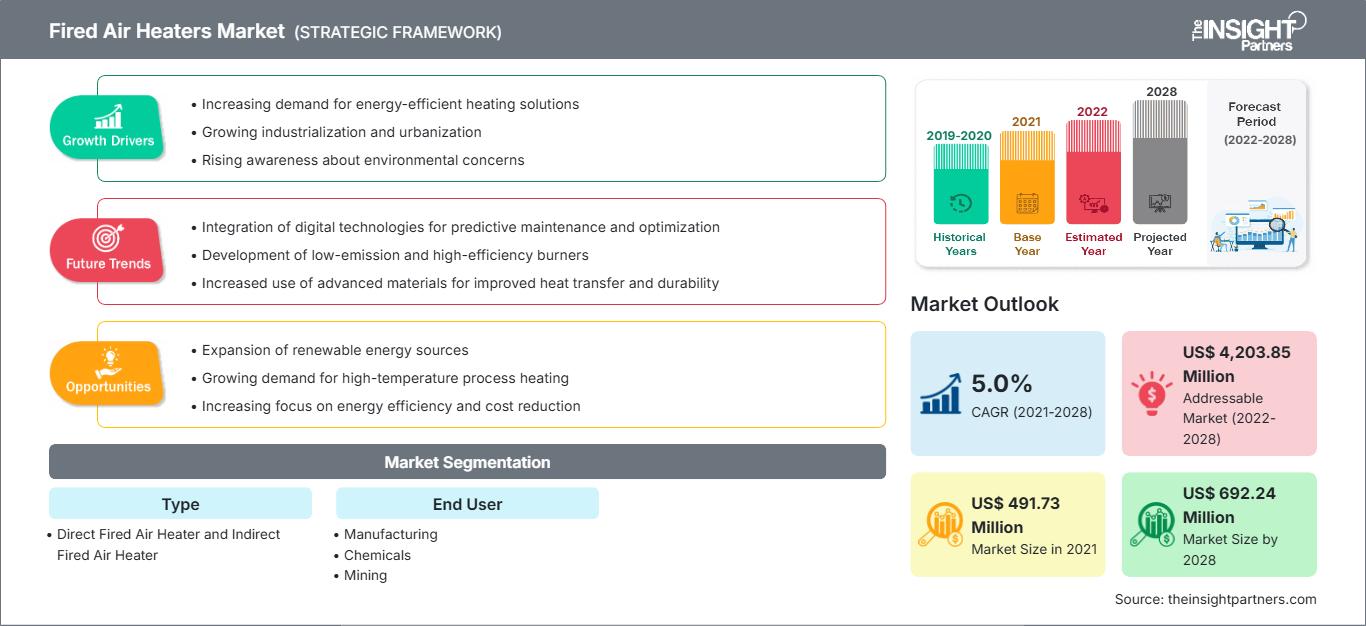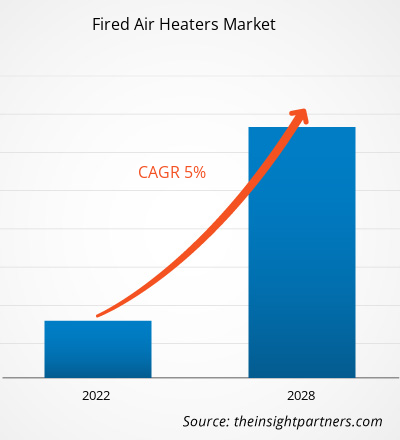预计火焰空气加热器市场规模将从 2021 年的 4.9173 亿美元增长到 2028 年的 6.9224 亿美元;预计 2021 年至 2028 年的复合年增长率为 5.0%。
新兴国家对工业用加热设备的需求增长是火焰空气加热器市场的主要驱动力。中国、印度、日本和巴西等新兴经济体企业的能源需求增长推动了对火焰空气加热器的需求。此外,由于启动时间短、效率高、可靠性高,制造业、发电业和加工业对火焰空气加热器的需求也在增长。此外,发电能力投资的增加也是推动火焰空气加热器发展的另一个因素。由于产品生产技术数十年来的不断发展,对火焰空气加热器的需求持续大幅增长。
火焰空气加热器通常用于加工工业,将气体或液体加热到特定温度。此外,物联网 (IoT) 与火焰空气加热器的集成将增加火焰空气加热器的采用率,从而在预测期内推动市场增长。
自定义此报告以满足您的要求
您将免费获得任何报告的定制,包括本报告的部分内容,或国家级分析、Excel 数据包,以及为初创企业和大学提供超值优惠和折扣
燃烧空气加热器市场: 战略洞察

-
获取本报告的主要市场趋势。这个免费样本将包括数据分析,从市场趋势到估计和预测。
新冠疫情对火焰空气加热器市场的影响
新冠疫情对全球产生了重大影响,并持续席卷多个国家。在新冠疫情爆发之前,火焰空气加热器行业的产量一直在大幅增长。然而,新冠疫情的爆发导致全球各行业对火焰空气加热器的需求大幅下降,飞机制造商的订单量大幅下降,从而导致产量下降。产量下降对各零部件制造商的业务和相关技术产生了不利影响。此外,建筑、汽车和采矿业等终端用户的疲软也打击了市场积极性。因此,火焰空气加热器市场参与者的业务受到生产不稳定的严重影响。在新冠疫情肆虐期间,整个建筑行业陷入停顿,几乎没有资源来预测未来。美国、法国、俄罗斯和中国的多家生产单位暂停生产,以遵守政府关于封锁和保持社交距离的规定。建筑企业的新项目需求减少了20%到30%。此外,在建项目的停工进一步削弱了市场。这一因素对火焰空气加热器市场产生了负面影响。
火焰空气加热器市场洞察
工业加热设备需求增长
锅炉、热泵和熔炉是用于化工、食品、建筑、采矿和其他行业生产过程的工业加热设备。锅炉是一个密闭容器,水或其他液体在其中被加热并形成蒸汽,然后在高压下喷射时用于驱动机器。此外,热泵是一种将热量传递到温暖或凉爽区域的装置。此外,熔炉是中央供暖系统的重要组成部分。在胺和乙二醇再沸器中,必须先从碳氢化合物蒸汽中去除腐蚀性硫化氢和二氧化碳气体,然后才能将相应的燃料储存或引入天然气和原油精炼管道。与天然气蒸汽类似,乙二醇用于在分配天然气之前去除其中的水分。由于维护成本低且操作简单,这种加热器广泛应用于天然气、原油和加工行业。在化工过程领域,火焰加热器通常用于加热工艺流体并产生蒸汽。
在大多数情况下,火焰加热器是过程工业中能耗最高的加热器。本研究使用带有垂直管的箱式加热器来加热碳氢化合物流体。洗脱加热器是火焰空气加热器的一种特殊应用,需要独特的设计,常用于采矿业。在分析化学和有机化学中,洗脱是指用溶剂洗涤从另一种物质中提取一种物质的过程,几乎总是伴随加热。金等矿物的提取需要使用交换器。矿物和溶剂溶液在交换器的一侧循环,传热流体(通常是热流体)在另一侧流动。在食品工业中,尤其是在油炸生产线(例如土豆、小吃和预煮食品)中,传热流体加热器的应用尤为广泛。在设备中,循环的传热流体被加热,并通过交换器将其热量传递给油炸食品的油。一些装置已在此安装,类似于采矿洗脱工艺,其中煎炸油直接在锅炉中循环,锅炉随后用作燃烧空气加热器。在石化行业中,直燃式加热器有时用作传热流体加热器或间接加热器。化工厂和炼油厂中直燃式加热器的良好维护服务以及备件的一致性是其受欢迎的主要原因,因为传热流体加热器以其特定功能的优势而闻名。因此,各种工业应用对加热设备的需求不断增长,推动了火焰空气加热器市场的发展。
基于类型的市场洞察
根据类型,火焰空气加热器市场细分为直接燃烧式空气加热器和间接燃烧式空气加热器。直接燃烧式加热器通过保持适当的空燃比(天然气或丙烷),为工业环境提供一种安全加热方式。在直接燃烧式加热器中,气体直接输送到燃烧器,而气流则提供燃烧所需的氧气。气体与通过燃烧器挡板的空气混合。燃烧器设置为与气流平行且串联燃烧。由于大约100%的燃料转化为热量,因此燃料消耗和运行成本得以降低。
燃烧空气加热器市场
The Insight Partners 的分析师已详尽阐述了预测期内影响燃气空气加热器市场的区域趋势和因素。本节还探讨了北美、欧洲、亚太地区、中东和非洲以及南美和中美洲的燃气空气加热器市场细分和地域分布。
火焰空气加热器市场报告范围
| 报告属性 | 细节 |
|---|---|
| 市场规模 2021 | US$ 491.73 Million |
| 市场规模 2028 | US$ 692.24 Million |
| 全球复合年增长率 (2021 - 2028) | 5.0% |
| 历史数据 | 2019-2020 |
| 预测期 | 2022-2028 |
| 涵盖的领域 |
By 类型
|
| 覆盖地区和国家 |
北美
|
| 市场领导者和主要公司简介 |
|
火焰空气加热器市场参与者密度:了解其对业务动态的影响
由于消费者偏好的不断变化、技术进步以及对产品优势的认知度不断提高等因素,最终用户需求不断增长,推动了燃气空气加热器市场快速增长。随着需求的增长,企业正在扩展产品线,不断创新以满足消费者需求,并抓住新兴趋势,从而进一步推动市场增长。

- 获取 燃烧空气加热器市场 主要参与者概述
燃烧空气加热器市场的参与者采用合并、收购和市场举措等策略来保持其市场地位。以下列出了一些主要参与者的发展:
- 2018 年,Allmand Bros. Inc.(一家拥有 80 年历史的高性能便携式施工现场设备制造商,也是 Briggs & Stratton Corporation 的子公司)扩建了其位于内布拉斯加州霍尔德里奇的现有工厂,以提高制造能力并利用新技术加快产品上市速度。
- 2018 年,Pirobloc(导热油加热器设计和制造领域的领导者)在美国开设了一家子公司。Pirobloc USA 已成为现实,并已全面投入运营。
全球燃烧空气加热器市场细分如下:
燃烧空气加热器市场
- 直接燃烧空气加热器
- 间接燃烧空气加热器
燃烧空气加热器市场 – 按最终用户
- 制造业
- 化学品
- 采矿业
- 仓库
- 石油和天然气
- 制药业
- 其他
燃烧空气加热器市场 –按地理位置
- 北美
- 美国
- 加拿大
- 墨西哥
- 欧洲
- 德国
- 法国
- 意大利
- 英国
- 俄罗斯
- 欧洲其他地区
- 亚洲太平洋地区(亚太地区)
- 澳大利亚
- 中国
- 印度
- 日本
- 韩国
- 亚太地区其他地区
- 中东和中东地区非洲(MEA)
- 南非
- 沙特阿拉伯
- 阿联酋
- MEA其他地区
- 南美洲(SAM)
- 巴西
- 阿根廷
- SAM其他地区
公司简介
- ALLMAND BROS., INC
- Exotherm Corporation
- Hastings HVAC, Inc.
- Pirobloc, SA
- SIGMA THERMAL, INC
- Stelter & Brinck, Ltd.
- Tamarack Industries
- Therm Dynamics
- Wacker Neuson SE
- Zeeco, Inc
- 历史分析(2 年)、基准年、预测(7 年)及复合年增长率
- PEST和SWOT分析
- 市场规模、价值/数量 - 全球、区域、国家
- 行业和竞争格局
- Excel 数据集
近期报告
相关报告
客户评价
购买理由
- 明智的决策
- 了解市场动态
- 竞争分析
- 客户洞察
- 市场预测
- 风险规避
- 战略规划
- 投资论证
- 识别新兴市场
- 优化营销策略
- 提升运营效率
- 顺应监管趋势






















 获取免费样品 - 燃烧空气加热器市场
获取免费样品 - 燃烧空气加热器市场